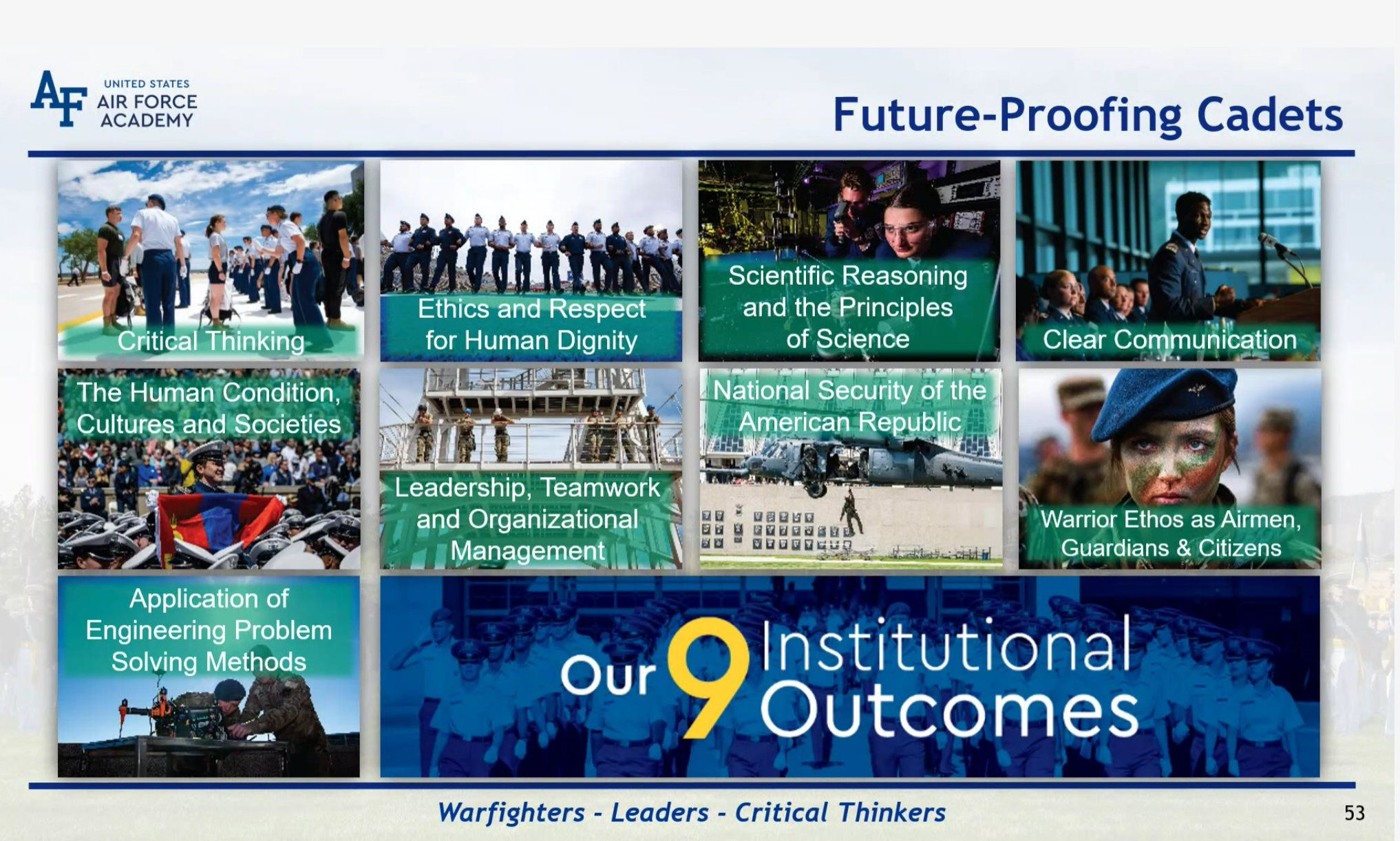USAFA Board of Visitors Convenes Oct. 23, 2024
The U.S. Air Force Academy Board of Visitors met on Oct. 23. The meeting was open to the public and accessible by way of Microsoft Teams. The board’s agenda for the Oct. meeting included:
- Opening remarks
- Superintendent’s update
- Discussion USAFA Priority: Warfighters to Win
- Discussion USAFA Priority: Leaders of Character and Quality
- Discussion USAFA Priority: Critical Thinkers to Adapt
- Public Comments
- Break (Deliberation on Action Items)
- Action Item Review
- Concluding Remarks
Established under Title 10 U.S. Code 9455, the Board of Visitors inquires into the morale, discipline, curriculum, instruction, physical equipment, fiscal affairs, academic methods and other matters relating to the Academy which the Board decides to consider.
The Board consists of six members appointed by the president of the United States, three appointed by the vice president of the United States, four appointed by the speaker of the House of Representatives, one designated by the Senate Armed Services Committee and one designated by the House Armed Services Committee.
Superintendent Lt. Gen. Tony Bauernfeind ’91 kicked off the BOV meeting by overviewing his priorities: developing warfighters to win, leaders of character and quality, and critical thinkers to adapt.
Presenting with Gen. Bauernfeind on these topics and a variety of others were Maj. Gen. Thomas Sherman ’95, USAFA vice superintendent; Brig. Gen. Linell Letendre ’96, dean of the faculty; Col. Beth Makros ’98, permanent professor and chief learning officer for the commandant of cadets; Col. Matthew Husemann ’00, special assistant to the commander, USAFA; Col. Amy Glisson ’01, installation commander; and Sonja Strickland, U.S. Air Force violence prevention program manager.
Gen. Bauernfeind shared the geostrategic importance of his priorities, especially framed against challenges posed in the Middle East and by Russia and China.
The superintendent said change is necessary in order to prepare for Great Power Competition, and losing is not an option. He said USAFA graduates must be ready to lead on Day 1.
- Key components of developing warfighters include:
- Integrating more military training in cadet programs;
- Establishing adequate military training ranges;
- Producing capable leaders who can deter threats and, if necessary, win our nation’s wars.
- Key components of graduating leaders of character include:
- Focusing on ethical decision-making — leaders “doing the right thing the right way;”
- Developing character through academic and team-building experiences, and personal accountability;
- Implementing crucible exercises that present complex, real-world dilemmas; and
- Ensuring cadets learn to uplift and support one another.
- Key components of cultivating critical thinkers include:
- Encouraging adaptability and critical thinking skills in response to evolving geopolitical challenges; and
- Training that simulates dynamic environments and an emphasis on adaptable planning.
The superintendent also discussed USAFA’s transition from a fourth-class training program to a structured four-class system focused on progressive leadership development.
This includes team-based assessments and evaluation and recognition of individual performance. He said the Academy must have a culture of respect that begins with leadership.
Gen. Bauernfeind talked about what he called “heritage-minus.” He said cadets should be proud of the legacy of past leaders and accomplishments, but that the Academy must also recognize historical shortcomings. He said, overall, the Academy is committed to rigorous training and character development to prepare future leaders to make complex decisions.
The group discussed cadet scheduling adjustments to ensure adequate attention is provided to military training. The superintendent said USAFA will become much more demanding, but it will never be demeaning. He also emphasized the institution’s zero-tolerance policy against sexual assault, harassment, domestic violence and discrimination.
“It is absolutely unacceptable ever to visit violence on a teammate,” he said.
Gen. Bauernfeind ended opening statements by saying: “Many folks are going, ‘How are you going to get all this done?’ I will tell you we're going to get this done because my confidence is high. And my confidence is high for two reasons: The very first is because of the United States Air Force Academy. … I am very proud to be a part of this team. But even more so, my confidence is high because of the 4,167 cadets in our Cadet Wing. I have had a great opportunity over the last 80 days to talk with many of them and I will tell you we are absolutely getting the best and brightest from all four corners of our great nation. They have a fire in their belly. They have a fire in their eyes. They want to serve their nation. I will tell you, they want to surpass the standards … and they want to serve their nation as a future leader, and it's now our job to ensure that we best develop them so they can have successful careers.”
Among other topics discussed at the BOV meeting:
- Harmful behavior prevention and active efforts to implement recommendations from the Climate Transformation Task Force.
- The restoration of the chapel. The author of an email to the BOV expressed a concern over a perceived lack of urgency, as compared to other projects nearing completion. Col. Glisson explained the chapel’s restoration is a high priority and that funding issues, such as specific revenue streams, and the complexity of the project, including asbestos abatement, have slowed progress. Currently, over 75% of the project is complete, she said, and the use of the protective box allows construction to continue despite inclement weather.
- Catherine Smith, executive director of Zoomies Against Sexual Assault, had questions about the Academy's culture and support systems. Strickland said USAFA ensures cadets are informed of available care and within 14 days of their arrival at Basic Cadet Training and Information includes where physical offices are located, contact information and peer leadership that can assist. She added that USAFA leadership is addressing transportation gaps that could impact access to care. Implementation is reviewed at the monthly Community Action Team meetings and updated at the quarterly board meetings.
